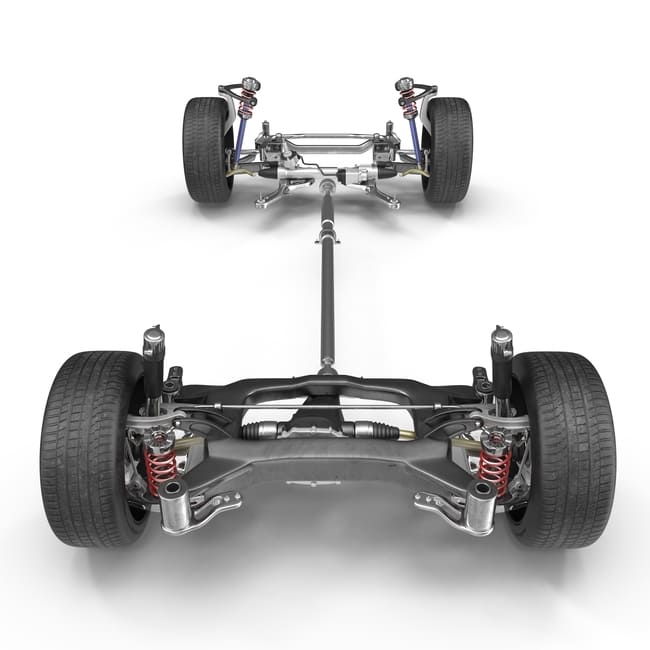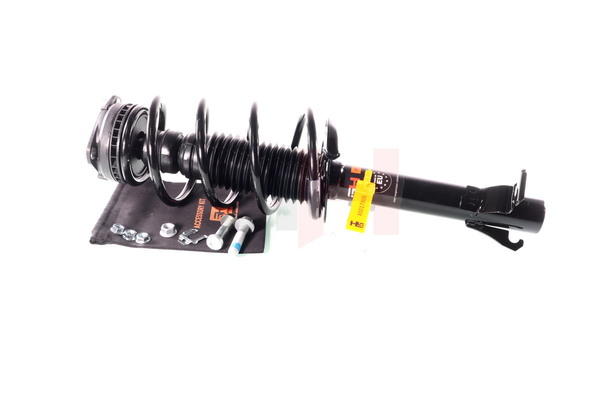Table of Contents
Car suspension: parts, failure symptoms, and repair costs
The suspension system plays a crucial role in vehicle stability, absorbing shocks from bumps, potholes, and uneven surfaces while ensuring the tyres maintain consistent contact with the road. This not only smooths out the ride for passengers but also enhances steering control and braking efficiency. It does this through a network of shock-absorbing components (such as springs, dampers, struts, and control arms) connected to the vehicle’s chassis.

There are two main types of suspension systems: dependent and independent. In dependent systems, the left and right wheels are connected to a single solid axle, ensuring that they remain parallel to each other. The issue with this is that when one wheel hits a bump, the whole axle feels the impact and the other wheel is affected. This makes the car more susceptible to body roll. Independent systems, on the other hand, allow the wheels to move independently of each other, meaning that jarring can be contained to one side of the axle.
What are the main suspension components?
Sold by AUTODOC Sold by AUTODOC Sold by AUTODOC Sold by AUTODOC Sold by AUTODOC 

 TRW Shock absorber
Front Axle, Gas Pressure, Ø: 45, Twin-Tube, Suspension Strut
TRW Shock absorber
Front Axle, Gas Pressure, Ø: 45, Twin-Tube, Suspension Strut
 GH Suspension Strut
Front Axle, Right, Left, Front Axle Right, Front Axle Left
GH Suspension Strut
Front Axle, Right, Left, Front Axle Right, Front Axle Left

If you want to know what to replace and how often to replace it, you’ll first need to familiarise yourself with the different car suspension parts. Here are some of the key components that you’ll need to pay attention to:
Springs

The springs play a critical role in dampening impacts from collisions or friction. They also help to increase the traction of the wheels. As the car hits a bump or dip in the road, the springs on the axle are compressed to absorb the shock. Common types include coil springs, leaf springs, and torsion bar springs.
Shock absorbers (shocks)

As the name suggests, the rear and front shock absorber in cars work alongside the springs to absorb shocks and dampen oscillations when driving. They are sometimes known as dampers because they dampen vibrations by turning kinetic energy into heat energy using hydraulic fluid. This helps prevent excessive bouncing and improves control, especially on rough terrain.
Control arms
The upper and lower suspension arm connect the car frame to the steering knuckle or wheel hub assembly. Some suspension systems will only have a lower control arm. The parts move up and down as the wheels move over bumps, for example, helping to keep the tyres in contact with the road and keeping the vehicle stable when turning.
Sold by AUTODOC Sold by AUTODOC Sold by AUTODOC Sold by AUTODOC Sold by AUTODOC 

 GH Suspension Strut
Front Axle, Right, Left, Front Axle Right, Front Axle Left
GH Suspension Strut
Front Axle, Right, Left, Front Axle Right, Front Axle Left


Ball joints

Found mostly at the front of the car, ball joints connect the control arms to the steering knuckle. They allow both vertical movement (from suspension travel) and horizontal pivoting (for steering), enabling smooth turning and handling.
Signs your car suspension needs to be repaired
A failing suspension system can compromise your safety and driving comfort. Below are some of the most common signs that indicate your car suspension may require inspection or repair:
Squatting, diving or rolling
If your car dives nose-first when braking, squats during acceleration, or leans excessively in corners, it could be due to worn or faulty shock absorbers. A visibly lower ride height may also point to broken or sagging springs.
Drifting or pulling to one side when driving
A common sign of a worn suspension system is that your car drifts or pulls to one side when making turns or driving forward. You’ll need to check the shocks, ball joints and control arms for signs of damage. When these components are worn or broken, it often affects the wheel alignment.
A bumpy ride
When you begin to feel every bump or pothole, it’s likely that your shock absorbers or struts are no longer functioning effectively. AUTODOC experts recommend trying this bounce test to assess the condition:
- Park the car on a level surface.
- Push down hard on the bonnet using your full body weight.
- Release and count how many times the car bounces.
If it bounces more than 3 times, the suspension likely needs attention.
Oily shocks
If you take a quick look at the shock absorbers under the vehicles, you may notice that they look like they’re covered in oil or grease. This usually means that they are leaking fluid. If they lose too much fluid, they will be ineffective.
Steering problems
When your suspension is acting up, it can often cause steering difficulties, particularly when driving at low speeds. This is because the two systems are deeply interconnected. It is best to get the vehicle diagnosed and fixed by a professional in this case.
Uneven tyre wear
This is often referred to as tyre ‘cupping’. When the suspension is putting uneven amounts of pressure on the tyres due to damaged or worn components, you may find that there are random bald spots on the tread. These spots usually measure around 3 to 4 inches.
How much does it cost to repair or replace the car suspension system?
The cost of suspension repairs can vary significantly depending on the faulty component, the car’s make and model, and whether the work includes labour or just parts. For instance, replacing a front shock absorber in the UK costs around £300 to £350, including labour. A suspension arm ball joint replacement may range from £60 to £150, depending on the vehicle.
Typical suspension repair costs in the UK
| Suspension component | Average price range (incl. labour) |
| Front shock absorbers | £300 – £350 |
| Rear shock absorbers | £250 – £320 |
| Suspension arm ball joint | £60 – £150 |
| Control arm (single) | £150 – £300 |
| Full suspension system (all corners) | £800 – £1,500+ |
Frequently Asked Questions
Conclusion
Your car’s suspension system plays a vital role in ensuring a smooth, safe, and controlled driving experience. From absorbing road shocks to maintaining proper wheel alignment and steering response, each component works together to keep your vehicle stable and comfortable. Recognising the early signs of wear such as excessive bouncing, drifting, or uneven tyre wear, can help prevent more serious issues and costly repairs.
Regular inspections and timely replacements of key parts like shock absorbers, springs, or control arms can extend the lifespan of your suspension system and improve overall vehicle safety. Whether you're a seasoned driver or new to car maintenance, staying informed about these components can help you make better decisions when visiting a mechanic or shopping for parts.
Useful videos on this topic:
Top 5 reasons why the suspension knocks
How to fix a knocking and creaking suspension
Top products related to this topic:










